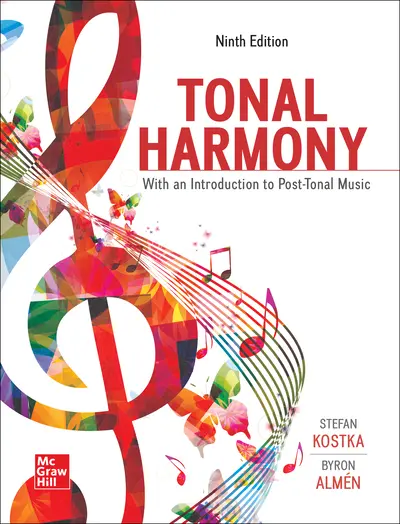My Account Details

ISBN10: 1265307350 | ISBN13: 9781265307356

Tonal Harmony, 9th Edition
- Lowest Price!
McGraw Hill eBook
Loose-Leaf Purchase
Unbound loose-leaf version of full text
Shipping Options
- Standard
- Next-day air
- 2nd-day air
Orders within the United States are shipped via FedEx or UPS Ground. For shipments to locations outside of the U.S., only standard shipping is available. All shipping options assume the product is available and that processing an order takes 24 to 48 hours prior to shipping.
Hardcopy
Complete text bound in hardcover or softcover
Shipping Options
- Standard
- Next-day air
- 2nd-day air
Orders within the United States are shipped via FedEx or UPS Ground. For shipments to locations outside of the U.S., only standard shipping is available. All shipping options assume the product is available and that processing an order takes 24 to 48 hours prior to shipping.
Note: Connect can only be used if assigned by your instructor.
Connect (3 Years Access)
- Digital access to a comprehensive online learning platform
- Includes homework, study tools, eBook, and adaptive assignments
- Download the free ReadAnywhere app to access the eBook offline
Connect + Loose-Leaf
- Comprehensive online learning platform + unbound loose-leaf print text package
- Connect includes homework, study tools, eBook, and adaptive assignments
- Download the free ReadAnywhere app to access the eBook offline
Shipping Options
- Standard
- Next-day air
- 2nd-day air
Orders within the United States are shipped via FedEx or UPS Ground. For shipments to locations outside of the U.S., only standard shipping is available. All shipping options assume the product is available and that processing an order takes 24 to 48 hours prior to shipping.
McGraw Hill eBook
Details:
- Normally the lowest price option for student
- Integrates in your LMS
- Accessible tools for students, including read-aloud functionality, jump links and dynamic note-taking and highlighting features
Loose-Leaf Purchase
Details:
- Unbound loose-leaf version of full text
Hardcopy
Connect (3 Years Access)
Details:
- Integrates in your LMS
- Prebuilt courses, presentation slides and instructor resources
- Test question banks, adaptive assignments, essay prompts, video content and more interactive exercises specific to your course subject
- eBook access (with included ReadAnywhere app)
- Print book add-on availability
- Remote proctoring
Connect + Loose-Leaf
Details:
- Comprehensive online learning platform + unbound loose-leaf print text package
- Connect includes homework, study tools, eBook, and adaptive assignments
- Download the free ReadAnywhere app to access the eBook offline
* The estimated amount of time this product will be on the market is based on a number of factors, including faculty input to instructional design and the prior revision cycle and updates to academic research-which typically results in a revision cycle ranging from every two to four years for this product. Pricing subject to change at any time.
Tonal Harmony with an Introduction to Post-Tonal Music is intended for a two-year course in music theory/harmony. It offers a clear and thorough introduction to the resources and practice of Western music from the seventeenth century to the present day. Its concise, one-volume format and flexible approach make the book usable in a broad range of theory curricula. For a generation of professionals in the musical community, Tonal Harmony has provided a comprehensive, yet accessible and highly practical, set of tools for understanding music. With McGraw Hill’s Connect®, students are better equipped to understand and master the vocabulary of music efficiently, allowing them to move on more quickly to advanced musical skill-building.
Chapter 1: Elements of Pitch
Chapter 2: Elements of Rhythm
Chapter 3: Introduction to Triads and Seventh Chords
Chapter 4: Diatonic Chords in Major and Minor Keys
Part II: Diatonic Triads
Chapter 5: Principles of Voice Leading
Chapter 6: Root Position Part Writing
Chapter 7: Harmonic Progression and the Sequence
Chapter 8: Triads in First Inversion
Chapter 9: Triads in Second Inversion
Chapter 10: Cadences, Phrases, Periods, and Sentences
Chapter 11: Two-Part Tonal Counterpoint
Chapter 12: Nonchord Tones 1
Chapter 13: Nonchord Tones 2
Part III: Diatonic Seventh Chords
Chapter 14: The V7 Chord
Chapter 15: Other Diatonic Seventh Chords
Part IV: Chromaticism
Chapter 16: Secondary Functions 1
Chapter 17: Secondary Functions 2
Chapter 18: Modulations Using Diatonic Common Chords
Chapter 19: Some Other Modulatory Techniques
Chapter 20: Larger Forms
Part V: Chromaticism 2
Chapter 21: Mode Mixture and the Neapolitan
Chapter 22: Augmented Sixth Chords
Chapter 23: Enharmonic Spellings and Enharmonic Modulations
Chapter 24: Further Elements of the Harmonic Vocabulary
Chapter 25: Tonal Harmony in the Late Nineteenth Century
Part VI: An Introduction to Twentieth-Century Music
Chapter 26: Materials and Techniques
Chapter 27: Post-Tonal Theory
Chapter 28: New Directions
About the Author
Stefan Kostka
Byron Almén
Need support? We're here to help - Get real-world support and resources every step of the way.